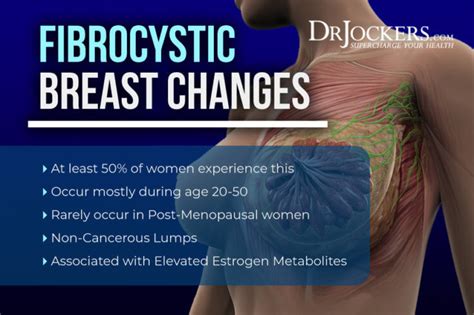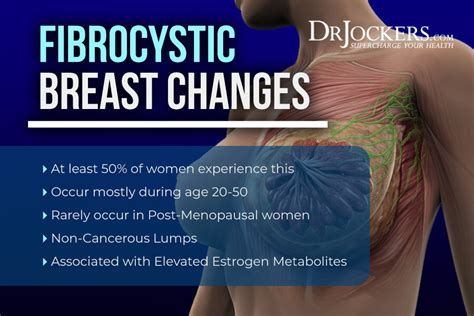Intro
Discover how fibrocystic changes impact breast health, causing lumps, tenderness, and cysts, affecting breast density, tissue, and overall breast wellness, leading to diagnostic challenges and concerns about breast cancer risk.
Fibrocystic changes are a common condition that affects many women, causing a range of symptoms and changes in the breasts. These changes can be uncomfortable and may cause concern, but understanding what they are and how they affect the breasts can help alleviate worries and promote better breast health. Fibrocystic changes are not a disease, but rather a natural response of the breast tissue to hormonal fluctuations, particularly in response to the menstrual cycle. As women approach menopause, the frequency and severity of these changes may decrease. However, for many women, fibrocystic changes can significantly impact their daily lives, from causing discomfort to affecting self-examination and screening practices.
The impact of fibrocystic changes on the breasts is multifaceted, involving both physical symptoms and changes in breast tissue composition. Women with fibrocystic changes may experience a variety of symptoms, including breast tenderness, lumpiness, and nipple discharge. These symptoms can vary in severity and may change throughout the menstrual cycle, often worsening just before menstruation. Understanding these changes and their effects on the breast can help women better navigate their breast health, from performing self-examinations to interpreting mammography results.
Breast health is a critical aspect of women's overall well-being, and any changes, whether due to fibrocystic changes or other conditions, should be monitored and discussed with healthcare providers. Regular breast self-examinations and annual mammograms are essential for early detection of any abnormalities. Moreover, a thorough understanding of fibrocystic changes can empower women to manage their symptoms more effectively, reduce anxiety related to breast health, and make informed decisions about their care. By exploring the ways in which fibrocystic changes affect the breasts, women can take a proactive approach to maintaining their breast health.
Introduction to Fibrocystic Changes

Causes of Fibrocystic Changes
The exact cause of fibrocystic changes is not fully understood, but they are believed to be related to the way breast tissue responds to hormonal fluctuations. Estrogen and progesterone stimulate the growth of milk-producing glands and ducts in the breast, leading to an increase in the number of cells and the amount of tissue. In some women, this stimulation can cause an overgrowth of tissue, resulting in the formation of cysts and fibrous tissue. Factors such as family history, diet, and lifestyle may also influence the development and severity of fibrocystic changes.Symptoms of Fibrocystic Changes

Diagnosis of Fibrocystic Changes
Diagnosing fibrocystic changes typically involves a combination of clinical examination, imaging studies, and, in some cases, biopsy. A healthcare provider will perform a physical examination of the breasts to assess for any palpable abnormalities. Imaging studies such as mammography, ultrasound, or MRI may be recommended to further evaluate any suspicious areas. If a lump is found, a biopsy may be necessary to determine if the tissue is benign or malignant.Managing Fibrocystic Changes

Impact on Breast Cancer Risk
Fibrocystic changes are generally not considered to increase the risk of breast cancer. However, having fibrocystic changes can sometimes make it more challenging to detect breast cancer through self-examination or mammography, as the lumps and thickened tissue can obscure or mimic tumors. Regular screening and follow-up with a healthcare provider are essential for women with fibrocystic changes to ensure any changes or abnormalities are promptly identified and evaluated.Self-Care and Monitoring

Support and Resources
For women dealing with fibrocystic changes, seeking support and accessing resources can be incredibly beneficial. This can include talking to healthcare providers, joining support groups, or seeking information from reputable health organizations. Staying informed and connected can help women manage their condition more effectively, reduce anxiety, and improve their overall quality of life.Conclusion and Future Outlook

Final Thoughts
As research continues to uncover more about the causes and effects of fibrocystic changes, women can look forward to more targeted and effective management strategies. In the meantime, prioritizing breast health through regular screenings, self-examinations, and a healthy lifestyle remains the best approach for all women, regardless of whether they experience fibrocystic changes.What are fibrocystic changes, and how common are they?
+Fibrocystic changes are a condition characterized by the development of fibrous connective tissue and cysts within the breast, influenced by hormonal fluctuations. They are extremely common, affecting up to 60% of women at some point in their lives.
Do fibrocystic changes increase the risk of breast cancer?
+Fibrocystic changes are generally not considered to increase the risk of breast cancer. However, they can sometimes make it more challenging to detect breast cancer through self-examination or mammography.
How can women manage the symptoms of fibrocystic changes?
+Women can manage the symptoms of fibrocystic changes through lifestyle modifications, such as maintaining a healthy weight, exercising regularly, and avoiding caffeine. Over-the-counter pain relievers and, in some cases, hormonal therapies may also be recommended.
We invite you to share your thoughts and experiences with fibrocystic changes. Your comments and questions can help others understand and manage this common condition. Feel free to share this article with anyone who might benefit from this information, and let's work together to promote better breast health for all.
